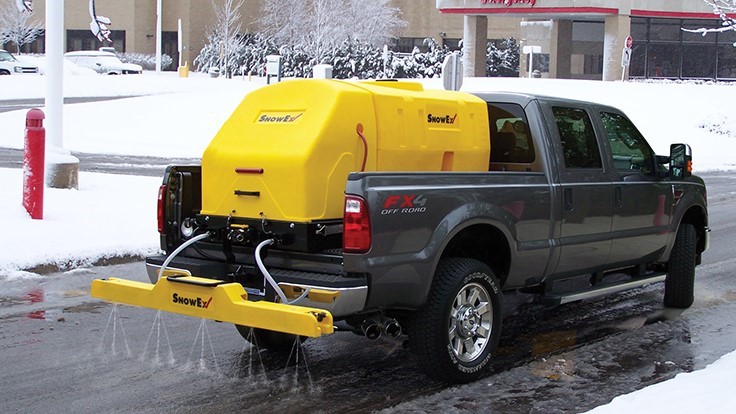10 Things To Know About Liquid Deicers
When used correctly liquid brine and blended products are powerful, cost effective tools. (Updated Aug. 2019)
EDITOR’S NOTE: This article was revised in August 2019 with updated content based on additional presentations and new source materials.
Snow and ice management professionals can decrease the time and cost of their operations by anti-icing — the application of liquid ice-melting materials to pavement before a storm hits, said Dale Keep, president, Ice & Snow Technologies, a consulting firm based in Walla Walla, Wash.
“The power of liquids is unbelievable once you understand them”, said Keep, who for 26 years worked with the Washington State Department of Transportation and spent four years advising the federal highway system on deicing issues. Keep is now a private consultant, who advises various public transportation authorities and private contractors.
Liquids aren’t the only tool in the toolbox when it comes to deicing, Keep says. “It may be one of the best, but it’s not the only one for every situation,” he says. “Know when to use it and when to put it away.”
Keep provides numerous points for snow and ice professionals to consider regarding liquid deicers:
Liquid Anti-icing Requires Less Material
Because rock salt rests on the pavement surface, it can be knocked off pavement by vehicle traffic. For example, studies show that traffic from as few as five cars can knock off 80 percent of solid ice-melting material, i.e. sand or rock salt.
In contrast, liquid ice-fighting materials penetrate the pores of road surfaces and therefore are not disturbed by vehicle traffic. As result, typically less material is required to melt ice, thus reducing the costs of a contractor’s operations.
Some professional estimates link liquid use with a 64% reduction in both material and labor costs.
Applying ice-melting chemicals before a storm hits, called anti-icing, is more effective at melting ice than applying an ice-melting material after a storm hits and a layer of ice has already formed. As a result, less material can be used, which will save the contractor money and time.
Further, because the materials penetrate the road surface, liquid ice-melting chemicals have a residual life within the pavement. In other words, if you apply a liquid ice-melting material before an anticipated storm and the storm never hits, the liquid will stay in the pavement ready to melt ice from the next storm. Be aware, however, that water will wash the liquid from the pavement, so if it rains, you’ll lose the material you applied.
The Key Is Cost, Not Price
The initial purchase price of liquid ice-fighting chemicals tends to be much more than bulk rock salt. However, when contractors look at the big picture of ice operations, such as total vehicle drive time and related expenses, storage requirements and level of service, they often find liquids to be more cost effective.
Anti-icing Saves Plowing Time
Because anti-icing involves applying liquids or granular salt before a snow event, the chemicals prevent a bond from forming between the pavement and snow. As a result, snow can be plowed easier and more quickly. Keep said plow time could be reduced by as much as five times.
To achieve this, contractors are using between 30 and 40 gallons of 23.3% liquid salt brine (2.1 lbs salt/gal) per acre (equivalent to 1 lane mile, 8 feet wide) of parking surface. Depending on weather and pavement conditions, a higher rate may be required after storm hits.
Liquids Are Not A Magic Bullet
Despite the benefits of anti-icing with liquid chemicals, the materials still represent just a piece of the total snow-fighting puzzle. “One tool is not best for everything. Liquid anti-icing is a powerful tool, but it’s not a magic bullet,” Keep said. “Both anti-icing and traditional de-icing will be needed for effective and efficient total storm management.”
Liquid Materials Require Knowledge and Experience.
All the benefits associated with anti-icing and the use of liquid ice-melting materials can be rendered void if the product is used improperly. All the materials have different windows of temperature and concentration when they are most effective. If you use the product outside of this performance window, you won’t get the results and you’ll end up wasting time and money. Tables, called freeze point curves, are available that demonstrate at what temperatures and concentrations various ice-melting chemicals will work. Manufacturers can supply contractors with these performance tables.
Further, as the material melts ice into water, the concentration of chemical in the water will become diluted. This dilution changes the effectiveness of the material. Only with the knowledge of the performance curve of the material being used can contractors adapt to this change and respond accordingly.
Use Ground Temperature
When working with ice-melting materials, knowing the temperature of the pavement on which the material will be used is the key to proper use, not the air temperature. As a result, contractors should use hand-held or truck-mounted infrared thermometers, which can measure ground temperature.
Document and Learn
The only way to gain experience with liquid anti-icing is to try it on a small scale and then learn from successive applications.
To achieve this, document your ice melting activities and their effectiveness. Keep recommends noting the following items in a log, each time you make a visit to an account:
- Air and ground temperature
- Application rate being used
- The ice-melting product being applied
- The results of the application. For example, upon return to the site do you find bare pavement, semi-bare pavement or do you still find a buildup of ice?
Monitoring the results of different applications can help you fine-tune your anti-icing efforts, resulting in more efficient operations.
Change Your Contracts To Fi
For contractors who bill customers per-hour or by the amount of salt used, increasing efficiency by anti-icing with liquid materials would mean an initial loss in revenue. Not a good thing.
However, being more efficient means contractors can save overall expenses and find the time to fit in more customers, meaning more revenue and more profit.
As a result, contractors should consider changing their contracts to fit anti-icing efforts, such as billing clients on a seasonal or per-occurrence basis. Keep worked with one contractor, who after seeing the benefits of anti-icing, went back to a client and asked the client to change from their hourly billing method to a seasonal fee. Because of the efficiency of anti-icing, the contractor was able to reduce the overall cost to his customer, but at the same time increase his profit from the job.
“You need to decide when it is to your benefit,”
Keep said.
“It is an economic decision that should be made by you and your company.”
Customer Education Needed
Anti-icing with liquid materials requires customer education. Most customers are accustomed to seeing a contractor apply salt after a storm hits. The customer, in fact, often judges the contractor’s worth by the amount of salt he sees on the ground at his facility.
With liquid materials, there is no evidence that a contractor has visited the account because the liquid penetrates the pores of the surface and leaves little to no residue. Further, some customers are suspicious of anti-icing. A customer might ask, “Why are you servicing my lot when it hasn’t even begun to snow yet?”
Accordingly, before moving to anti-icing with liquid materials, contractors must explain the change to customers, how liquid anti-icing works and demonstrate the effectiveness of liquids. Some contractors have offered a one-time trial to customers to prove their point.
Ask For The Data
When evaluating different ice-melting materials ask the manufacturer for all the relevant product performance data. “If you don’t get it, there’s probably a reason,” Keep said.
The author of the original 2003 article was Steve Smith managing editor, Snow Business Magazine, which at that time was a GIE Media title. The article is based on a presentation by Dale Keep, who had spoken to nearly 50 contractors Aug. 5, 2003 during Snow & Ice Control Chemicals Theory & Practice, a one-day training event in Cleveland, organized by the Snow & Ice Management Association. The event was part of a series of seminars also held in Chicago and Newark, N.J. and sponsored by North American Salt and Monroe Snow & Ice Equipment.


